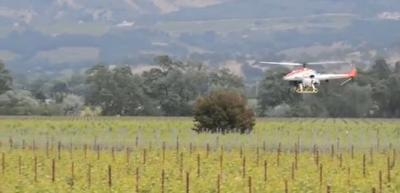Aircraft Used For Spraying Agricultural Fields For 20 Years In Japan Being Evaluated In CA
A remote-controlled helicopter, fitted with a spray applicator system, was field tested Wednesday over a vineyard in the heart of the famed Napa Valley by engineers at the University of California, Davis, and Yamaha Motor Corporation, USA.

For 20 years, the small motorcycle-sized RMAX helicopter has been used to apply agricultural sprays to rice fields in Japan and is now being tested for potential agricultural uses in the United States, in areas where aerial applications could prove to be safer and more efficient than tractor applications of herbicides and pesticides.
UC Davis is now one of the few universities in the nation with an FAA permit to apply sprays with remote-controlled aircraft. That permit applies only to specific agricultural areas, including the University of California Oakville Station. No flights are made in the vicinity of the Davis campus.
Flanked by some of the Napa Valley’s most historic winegrape vineyards, the Oakville Experimental Vineyard at the UC Oakville Station provides the ideal site for the field tests, which began in November 2012. “This site not only offers a working-vineyard situation, it also meets all of our federal requirements for flight zones for remote-controlled aircraft,” said Ken Giles, a UC Davis agricultural engineering professor and lead researcher on the project.
Giles noted that the FAA regulates use of all remote-controlled aircraft and requires, for example, that the aircraft not be operated within five miles of an airport, notice of a planned flight be reported to FAA 48 hours in advance and the aircraft’s flight altitude not exceed 20 feet. It took Giles and UC Davis development engineer Ryan Billing — both licensed commercial pilots — five months to obtain FAA clearance to operate the mini-helicopter in the Napa Valley. Experienced Yamaha flight instructors from Japan trained them on the fine points of operating the mini-helicopter.
The two UC Davis researchers are building a valuable database that will document how the RMAX might perform in agricultural operations in California and elsewhere in the United States. “We have more than two decades of data on the performance of the RMAX in Japan, but we don’t yet have that kind of information on its use in the United States,” said Steve Markofski, a Yamaha business planner and trained RMAX operator. He noted that in Japan more than 2,500 RMAX helicopters are being used to spray 40 percent of the fields planted to rice — that country’s number one crop.
“What Ken and Ryan bring to the table is their spray application expertise and knowledge of the current application methods that are in use in the United States,” Markofski said. “As we collaborate with them on tests of spray deposition and efficiency, we’re gaining insight into to how the RMAX performance compares to spray application methods that are being commercially used for this crop and this terrain.”

Currently, only water is being sprayed on the vineyards as the researchers explore how well the aerial applicator would cover the vineyard. Water-sensitive test papers are spotted at specific sites throughout the vineyards. Water droplets from the helicopter spray system leave on the paper tiny blue dots that, when recorded and computer analyzed, provide valuable information about where the spray is landing.
The helicopter is equipped with one eight-liter tank on either side of the fuselage, giving it the capacity to carry 16 liters, or slightly more than four gallons, of water or liquid spray. The aircraft has a recommended maximum spraying speed of approximately 15 mph, as it methodically moves up and down the vineyard rows. So far, the data indicate that the helicopter is providing thorough coverage across the vineyard and that the air currents stirred up by the helicopter rotors are causing the spray to reach even the undersides of the grapevine leaf canopy. Furthermore, the researchers have been impressed by the stability of the helicopter, even in gusty winds.
Eventually, the research team plans to conduct application tests with commonly used agricultural pesticides and herbicides. They will explore how well the helicopter compares to a tractor-drawn spray rig in terms of operator safety, cost and efficiency. They also are expanding the test flights to some almond orchards in California's Central Valley.
The results of the study — expected to be completed late this summer – will help determine where and how the mini-helicopter might play a role in U.S. agriculture. In Japan, where rice fields average about five acres and are often surrounded by residential or commercial development, the helicopter provides a safe, efficient method for applying agricultural sprays.
(Images captured from UC Davis YouTube video)
 Classic Aero-TV: The Switchblade Flying Car FLIES!
Classic Aero-TV: The Switchblade Flying Car FLIES! ANN FAQ: Q&A 101
ANN FAQ: Q&A 101 ANN's Daily Aero-Term (04.12.24): Discrete Code
ANN's Daily Aero-Term (04.12.24): Discrete Code ANN's Daily Aero-Term (04.13.24): Beyond Visual Line Of Sight (BVLOS)
ANN's Daily Aero-Term (04.13.24): Beyond Visual Line Of Sight (BVLOS) ANN's Daily Aero-Linx (04.13.24)
ANN's Daily Aero-Linx (04.13.24)




